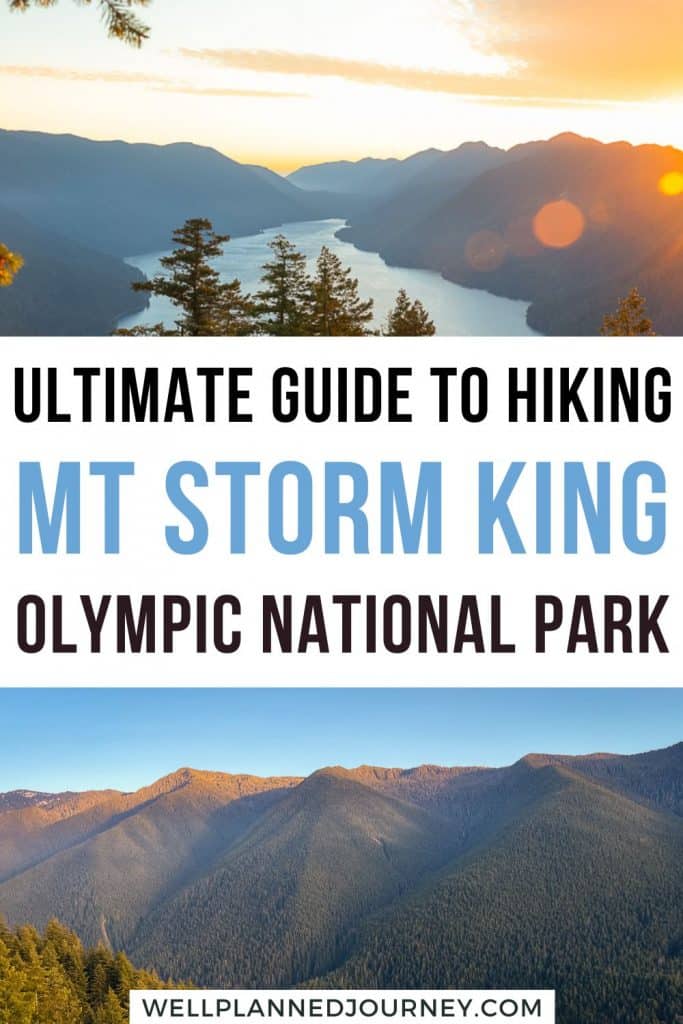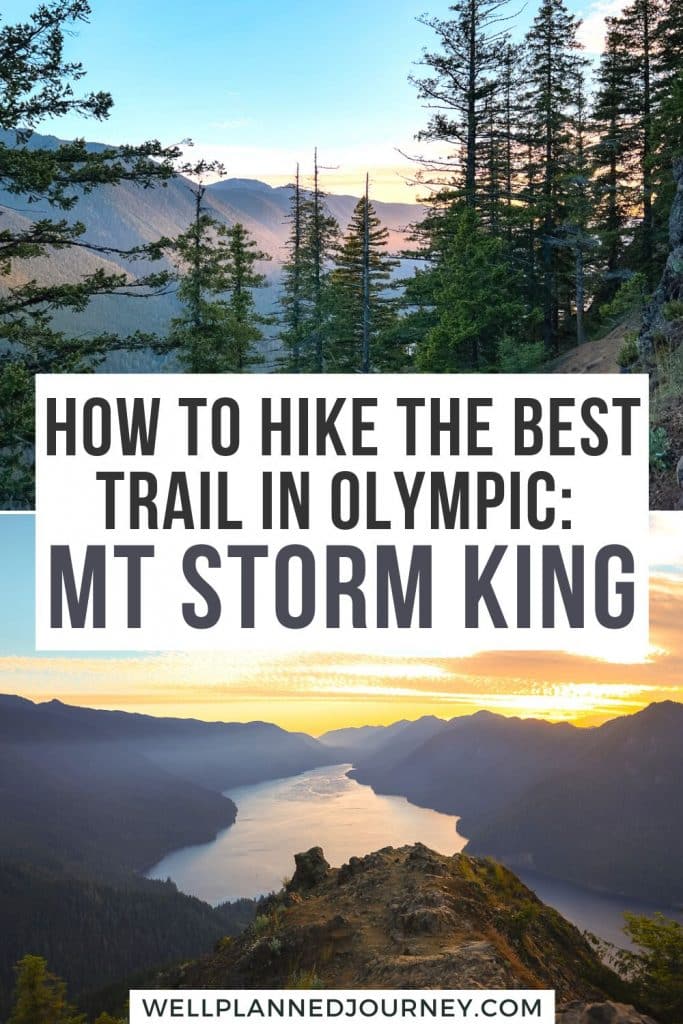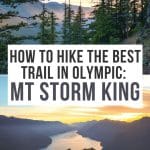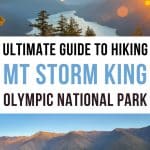Are you planning a trip to Olympic National Park and looking for the ultimate bucket list experience?
Look no further than the Mount Storm King Trail in Olympic National Park. This hike is challenging, scenic, and perfectly encapsulates the beauty of the Olympics.
That’s why it’s often rated as one of the best hikes in Olympic National Park!
This guide covers everything you need to know before hiking Mount Storm King in Olympic National Park, including getting to the trailhead, essential tips, what to pack, and all the must-know details.
This post may contain affiliate links, where I may receive a small commission at no additional cost to you. Read more in this disclosure policy.
Olympic National Park At-A-Glance
Before diving in, here are a few highlights to help you plan your trip:
- Best Time to Visit: July to September is the best time to visit when all roads are open and rain is minimal. Higher elevation areas like Hurricane Ridge are typically only open from mid-June to October.
- Where to Stay: The most conveniently located lodges in Olympic National Park are Lake Crescent Lodge and Kalaloch Lodge. If you want to stay outside the park, consider staying at the Olympic Lodge or the Woodlands Inn.
- How to Get There: The closest airport is in Seattle, 2 to 3 hours away. Use Expedia to browse flights and find the best price.
- How to Get Around: My favorite way to see Washington is by campervan. I had a fantastic experience renting a luxury campervan through Noma Vans on Outdoorsy. You can also easily get around by car. I recommend using Expedia to browse for deals.
- Don’t Forget: Be sure to get an America the Beautiful National Park Pass ahead of time. This $80 pass is valid for 12 months and gets you into all 400+ national park sites (including all 3 Washington parks).
Mount Storm King Hike At-A-Glance
This popular trail is strenuous but a relatively short distance. It starts near Lake Crescent before climbing to incredible panoramic views. Here are the stats for the hike.
- Distance: 4.1 miles
- Total Elevation Gain: 2,106 feet
- Starting Elevation: 600 feet
- Highest Elevation: 2,700 feet
- Trail Type: Out and back
- Difficulty: Hard
- Time to Hike: 3 to 4 hours
- Trailhead: Storm King Ranger Station
- Best Time to Visit: May to October
- Pets Allowed: No
- Read reviews on AllTrails
Mount Storm King Olympic National Park Map
Below is a map of the route to the top of Mount Storm King, starting at the Storm King Ranger Station. The trail initially follows the same path as the Marymere Falls Trail before splitting off onto steep switchbacks.
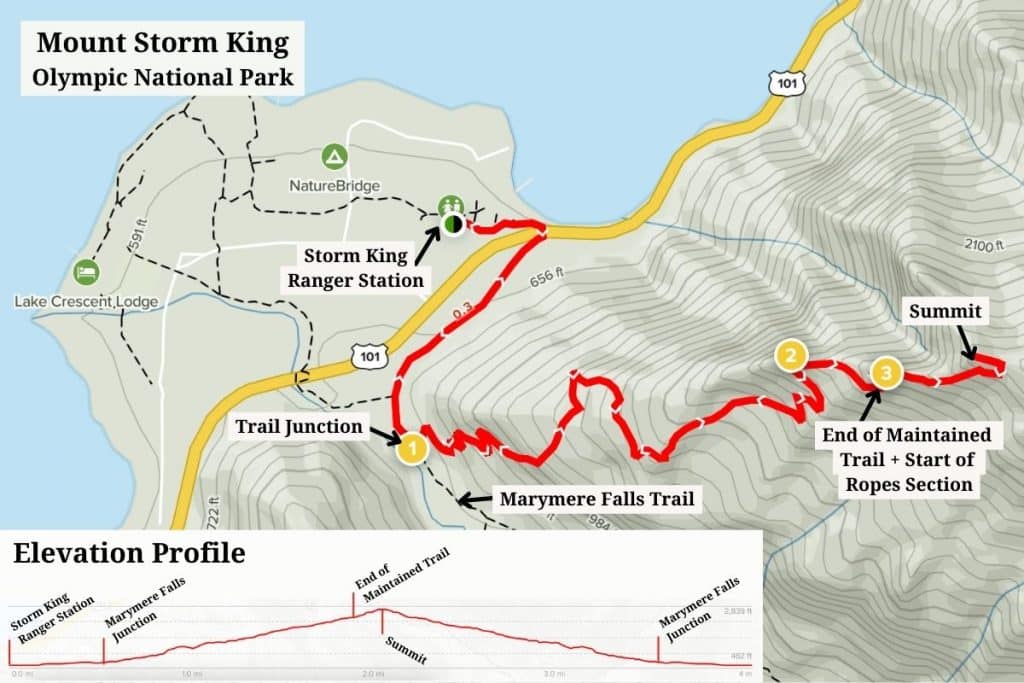
Best Time to Hike Mount Storm King
The best time to hike Mount Storm King is from late spring to mid-Fall, ideally from May to October. Summer brings warm weather and good trail conditions. However, this is also the busiest time of year.
If you choose to visit in the early-to-mid-Fall, you can avoid crowds. Another excellent way to avoid crowds on the Mount Storm King trail is by hiking at sunrise or sunset or on a weekday.
On summer weekdays, the rope section and steep summit only allow a few hikers at a time, resulting in wait times.
It’s also essential to hike Mount Storm King on a clear day. When conditions are cloudy or hazy, the incredible view over Lake Crescent can become obscured, making this a challenging hike without a reward!
Are you planning a national park trip but don’t know where to start? Get my free 28-page national park ebook where I break down everything you need to know to visit all 63 USA national parks.
Download your free ebook here.
Getting to the Mount Storm King Trailhead
Mount Storm King is located in the Lake Crescent area of Olympic National Park. From Seattle, it is about a 3-hour drive. You can either take the ferry or drive up the Olympic Peninsula.
From Port Angeles, it’s about a 30-minute drive to the trailhead.
The Mount Storm King trailhead is located along Highway 101 at the Storm King Ranger Station. You’ll look for the turn-off around mile marker 228 for Lake Crescent and make a right turn for the Marymere Falls parking lot.
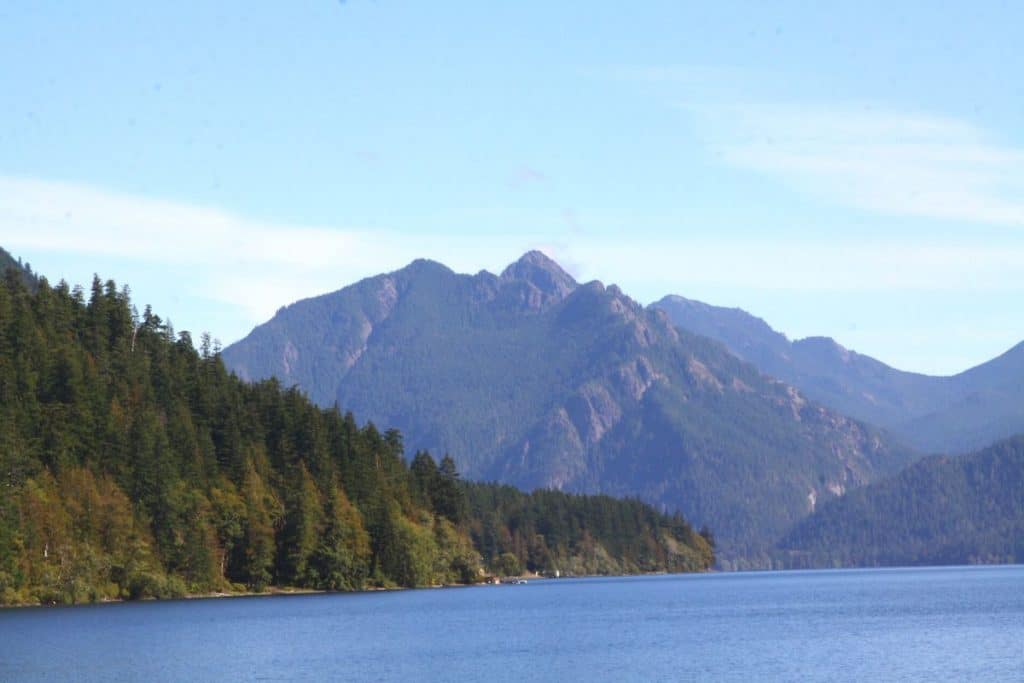
What to Know Before You Hike Mount Storm King
- Get a national park pass ahead of time. While you won’t pass through an entrance fee station to reach the Mount Storm King parking area, you are still technically required to pay admission. The easiest way to do this is by purchasing a national park pass. For only $80, you get unlimited access to all 400+ National Park Service sites, including all 3 Washington national parks!
- Arrive at the trailhead before 10 AM or after 4 PM in the summer. Since the parking lot is the starting point of several popular hikes, including Marymere Falls Nature Trail and Mount Storm King, parking is at capacity for most of the day in the summer.
- Only do the hike on a clear day. If conditions are rainy, cloudy, or hazy, wait until another day to hike Mount Storm King. Poor visibility ruins the experience and results in hiking steep trail switchbacks for nothing!
- Only hike Mount Storm King if you’re comfortable with the ropes section. I’ll describe the trail in more detail below, but the final stretch to the summit is an unmaintained trail that requires the use of ropes along steep cliffs. Unfortunately, you don’t get expansive views of Lake Crescent until halfway through the rope section, as most of the hike is in the woods, and you’ll need to clear the treeline to see the lake.
- Check trail conditions and the weather forecast before hiking. Rainy weather can make the trail unsafe or muddy. You can stay up-to-date on the latest trail conditions in Olympic National Park here.
- Cell service can be limited inside the park. Be sure to download Google Maps and trail maps offline. I highly recommend AllTrails Pro, as you can easily download maps on your device and navigate during your hike!
Are you visiting multiple national parks in the next year? The America the Beautiful National Park Pass gets you into 400+ national park sites, including all 63 national parks, for 12 months!
Get your national park pass ahead of time for only $80.
What to Pack for Your Mount Storm King Hike
- Hiking Boots with Good Traction – The final stretch of the trail to the summit is rocky and unmaintained. I recommend wearing hiking boots that provide ankle support and solid traction. My favorite hiking boots are the Columbia Newton Ridge. Don’t forget to wear merino wool socks to keep your feet dry and prevent blisters!
- Hiking Poles – While I don’t usually hike with poles, on trails like this one with a steep incline, they provide much-needed stability and support, particularly on the way down. Therefore, I recommend investing in a lightweight pair of trekking poles.
- Layers – Temperature can change dramatically throughout the day. While you may start cold, you’ll want to remove layers as you hike the strenuous trail. Pack moisture-wicking hiking shirts and warm fleece layers to keep you comfortable.
- Rain Jacket – While rain is less common in the summer, you should always be prepared for a Pacific Northwest light rain. Be prepared and carry a rain jacket or poncho.
- Hiking Backpack & Safety Essentials – Be sure to pack the ten hiking essentials and bring a backpack like the Osprey Tempest for women or Osprey Talon for men with plenty of room for water and extra gear.
- Headlamp with Extra Batteries – If you’re hiking at sunrise or sunset, pack a headlamp with fresh batteries, plus an extra set of batteries in your bag. I highly recommend the Black Diamond headlamp for its long battery life and hands-free hiking!
- Sun Hat and Sunscreen – The top of the trail on the ropes section and summit are unshaded, so protecting yourself from the sun is essential. Sunscreen and a sun hat are highly recommended.
Looking for more tips on what to pack for your trip? Check out my guides on the best hiking gear, what to pack for a road trip, and essential camping gear for all my favorite gear picks and tips to make packing for your trip a breeze!
Detailed Overview of the Mount Storm King Trail
The Mount Storm King hike is broken up into three distinct sections:
- The easy, flat trail until the split to Marymere Falls
- The steep hike ascent via trail switchbacks up to Mount Storm King
- The final, unmaintained rope section to the summit
I’ll detail each section, so you know what to expect when you hike Mount Storm King in Olympic National Park!
Start the Hike to Mount Storm King
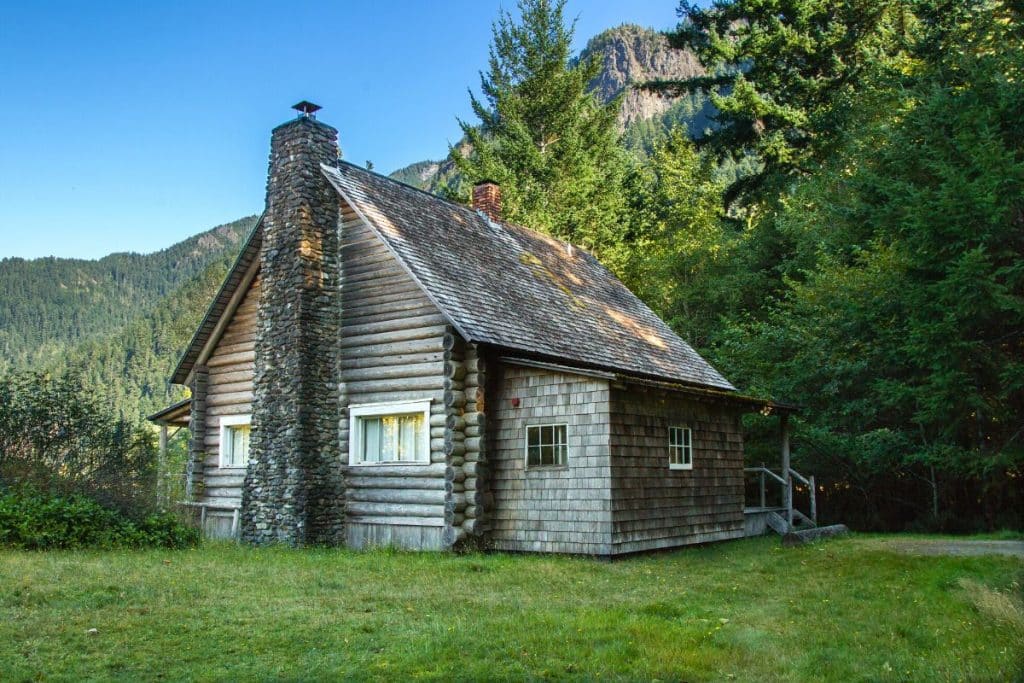
The trail starts at the Storm King Ranger Station near Lake Crescent Lodge. The trailhead and initial path are shared with the route to Marymere Falls.
The first part of the trail follows the southeast side of Lake Crescent before cutting under Highway 101 in a pedestrian tunnel. The path then opens into a wide trail through a fern-filled damp forest, continuing for the first half mile to the trail split.
At the split near the huge boulder, you can turn right to head up to Marymere Falls or head left to climb the steep switchbacks to Mount Storm King.
I recommend saving Marymere Falls until after hiking Mount Storm King to ensure you have enough energy.

The Climb to Mount Storm King
After turning onto the Mount Storm King route, the elevation gain begins. The switchbacks are nonstop, steep, and challenging, even for those in good shape.
You’ll wind through a dense old-growth forest filled with giant Pines, Hemlocks, Cedars, and other twisted trees, providing plenty of shade.
After about 1.2 miles and 1,400 feet of elevation from the split (~1.7 miles from the trailhead), you’ll get your first view of Lake Crescent and the Barnes Creek Valley facing north through the tree line.
This vista is an excellent spot for a more extended breather and recovery after an intense climb.
You’ll gain another 300 feet in only 0.2 miles as you continue on the trail. Here you’ll reach a sign marking the end of the maintained trail. You are no longer hiking on trails maintained by the National Park Service and continue at your own risk.
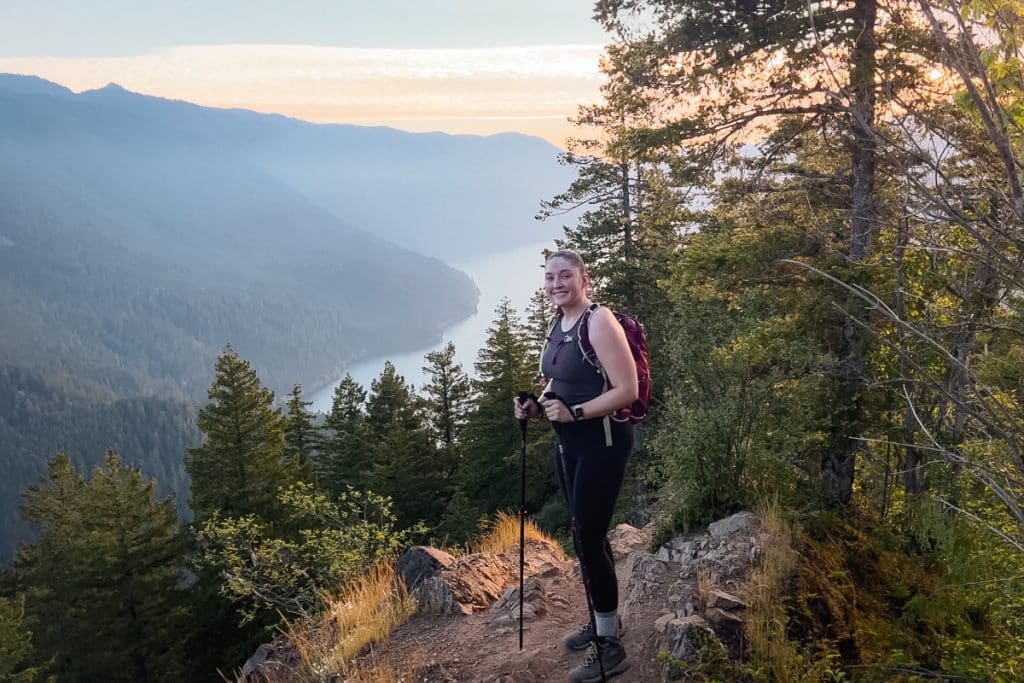
While you’ll get a few obstructed views of Lake Crescent and the Strait of Juan de Fuca from this point, the best views require reaching the summit and navigating the unmaintained trail.
Beyond this sign is where the most challenging part of the hike begins – the rope section!
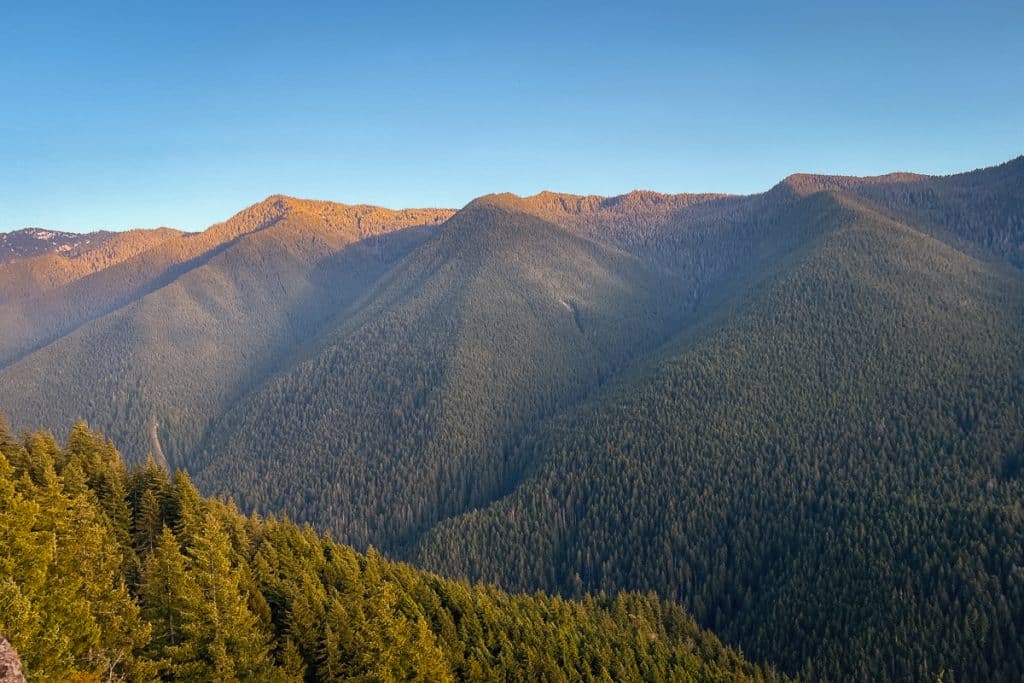
Ropes Section of Mount Storm King
The trail’s unmaintained portion is dramatically different from the switchbacks. The path becomes rocky, with loose gravel and dirt. At parts, the trail is almost vertical!
For this reason, ropes have been tied to trees and shrubs, allowing you to pull yourself to the top and assist with reaching the summit. The steep climb has loose ground, and there are 2,000+ foot drop-offs on either side of the trail.
This trail part can be terrifying if you’re scared of heights.
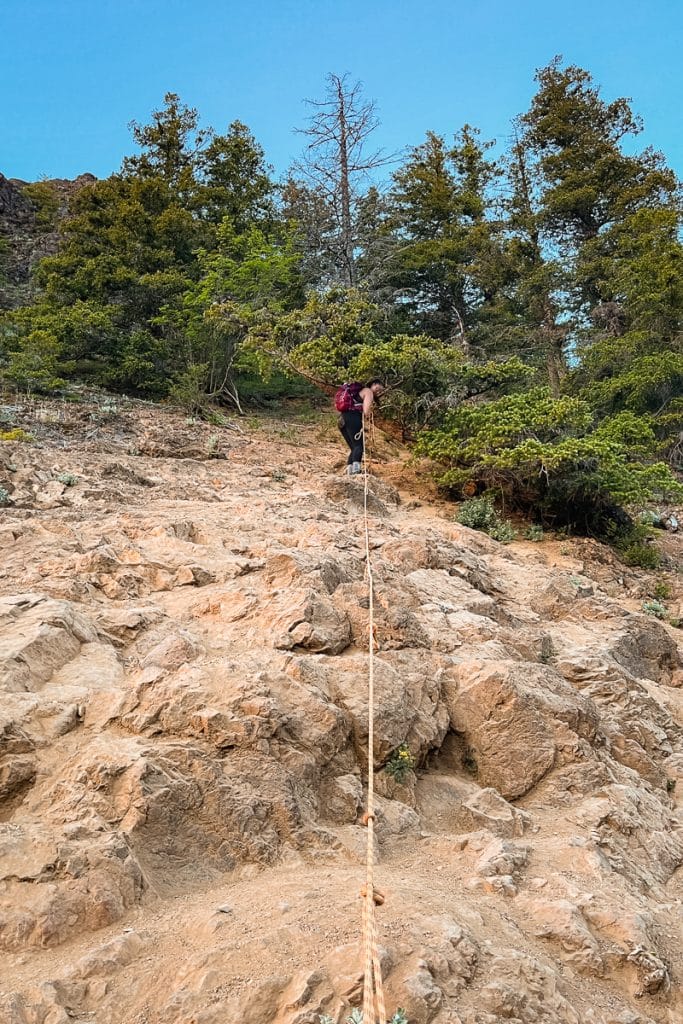
The trail climbs up a series of ropes, requiring you to release the first rope after your short scramble and grab onto a new rope. While there are a few tricky sections, it is primarily straightforward for those with proper hiking boots with good traction and in good shape.
Some hikers opt to bring gloves with a grip to avoid rope burn. I did not use gloves as I felt more comfortable holding the rope in my own hands. I did end up with a few calluses after the hike, though!
On busy summer weekends, you may have to wait a bit to climb the rope section as hikers go down while you’re going up. Waiting is essential because it’s only safe to have one hiker on the rope at a time.
I found trekking poles very useful for the switchback section of the hike. However, you’ll need both hands free to hike the rope section and scramble to the summit. So store your trekking poles in your backpack or leave them along the trail, picking them up before you head back down.
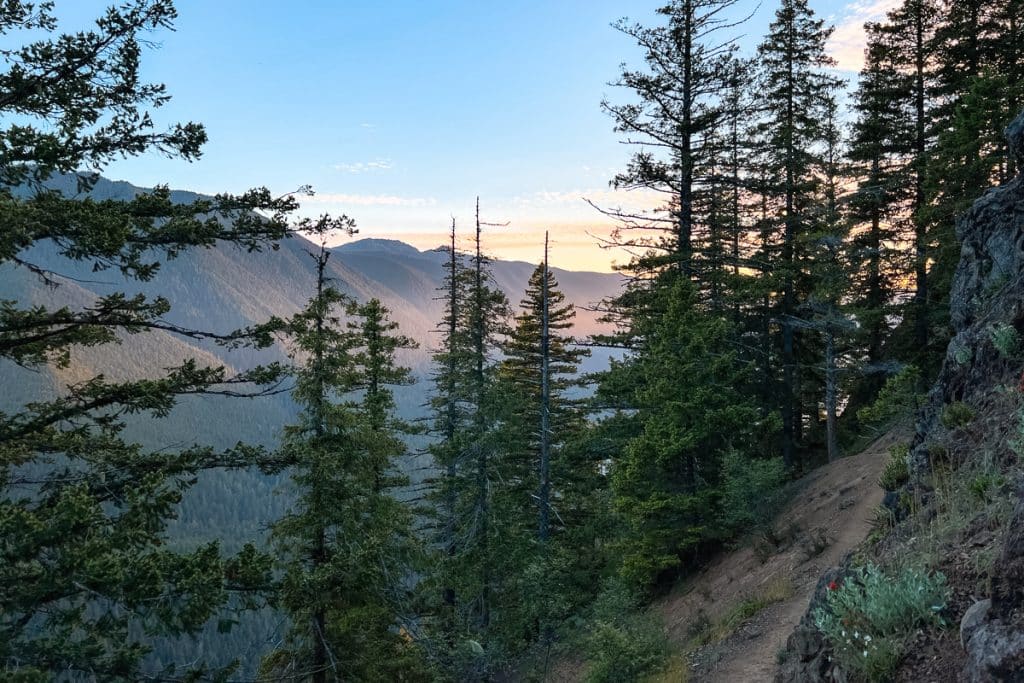

Mount Storm King Summit
After the ropes section, it’s just a short hike to the base of the summit. At first, I wasn’t sure if the summit’s base was where the trail continued – it just looked like a giant rock ridge! But rest assured, that is the trail.
You’ll rock scramble to the top and reach the summit of Mount Storm King. You’re literally on top of the mountain!
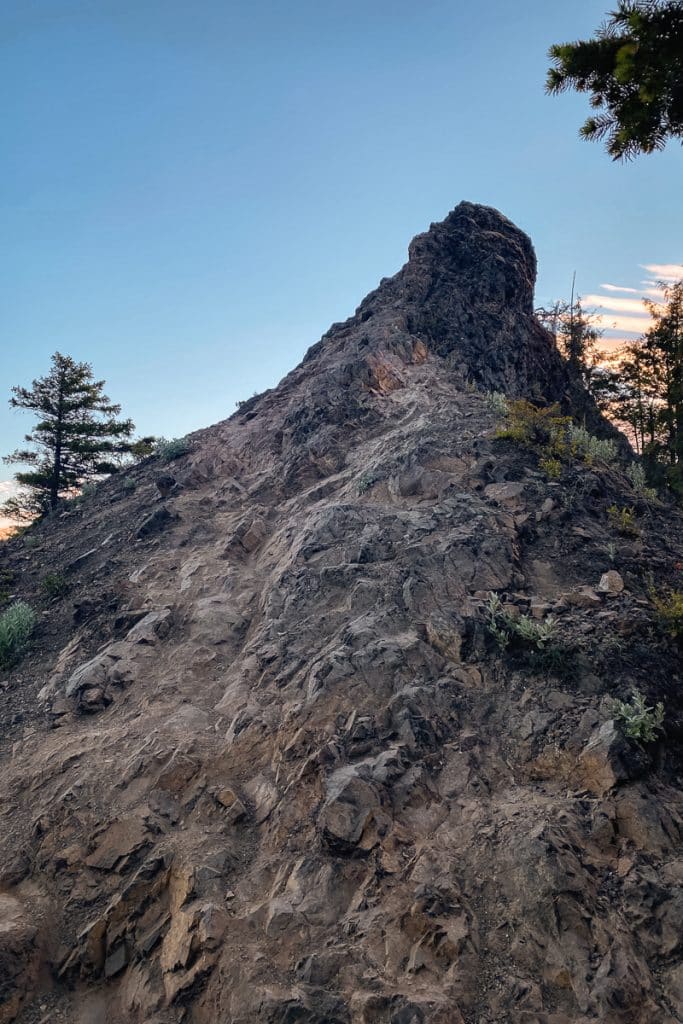
You’ll have unobstructed views of Lake Crescent to the north and west and the tree-covered Olympic mountains. At sunset, the sky glows orange, and the landscape is a beautiful hue.
On busy summer days, expect to have several other hikers waiting to reach the summit. The ridgeline is narrow, with room for only a few people. Take your pictures and head out if there’s a long line to reach the summit!
It can also get incredibly windy at the summit, so pack an extra layer or windbreaker in your backpack!
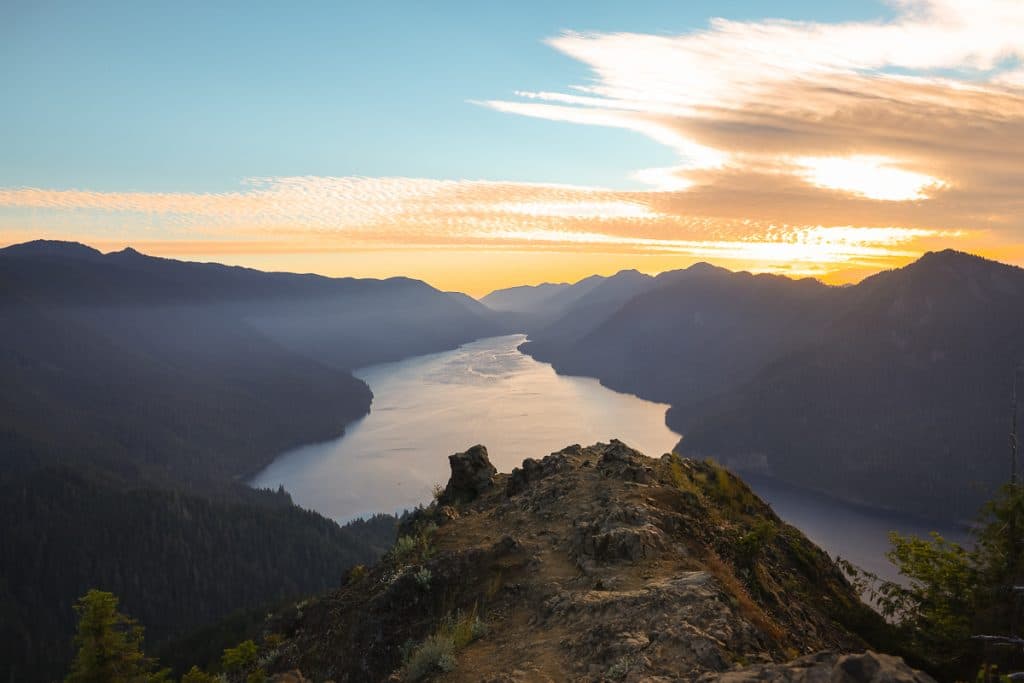
Descending Mount Storm King
The trickiest part of the hike is descending the rope section from the summit of Mount Storm King. The loose gravel and dirt make for slick footing.
Climb down slowly, one foot at a time like a ladder, holding on to the rope. Always make sure to have three points of contact!
If people are waiting to come up, you’ll need to stand to the side until the rope section is clear.
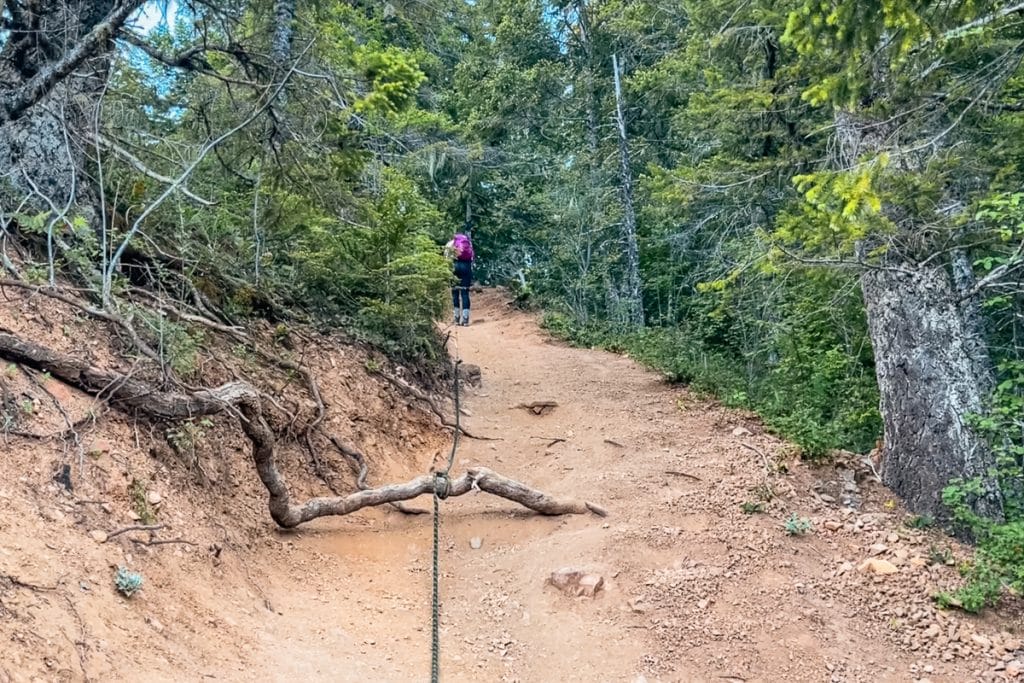
After reaching the bottom of the ropes section and returning to the maintained trail, you’ll follow the same steep switchbacks back down the mountain.
Again, take your time and use trekking poles to reduce the impact on your hips and knees.
Add Marymere Falls to Your Hike
Once you return to the split in the trail, you can continue to Marymere Falls if you have the energy. From the trail junction with the Mount Storm King trail, it is only 0.4 miles and around 250 feet of elevation gain to reach Marymere Falls, making it a great addition.
The trail continues through the same temperate rainforest where you began your hike, crossing bridges and following Barnes Creek and Falls Creek out to the waterfall.
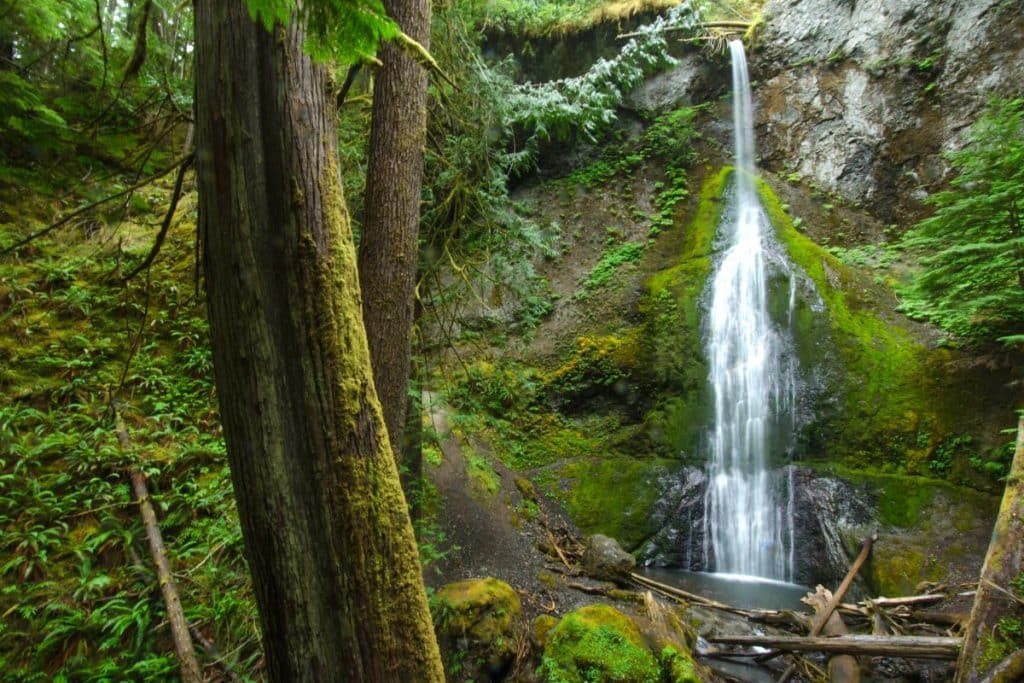
Marymere Falls comes into sight, tumbling nearly 100 feet over a moss-covered cliffside. It’s genuinely one of the most spectacular waterfalls in Olympic National Park.
If you add Marymere Falls after hiking to Mount Storm King, your total hike will be 5.3 miles with roughly 2,320 feet of elevation gain.
What to Do After Hiking Mount Storm King
After your hike, there’s plenty more to explore in the Lake Crescent area. Head to the Lake Crescent Lodge for a meal, souvenir shopping, or relaxation.
If you’re looking for another easy hike, consider walking along the Moments in Time Trail to cool down.
In addition, you can rent paddle boards and kayaks at the Lake Crescent Lodge if the weather is nice and explore the shores of the lake you’ve just seen from above.
After that, you can explore other popular regions of Olympic National Park, including Rialto Beach, Hoh Rainforest, and Hurricane Ridge.
If you’re looking for more hikes in those areas, check out this post on the 21 best trails in Olympic National Park!
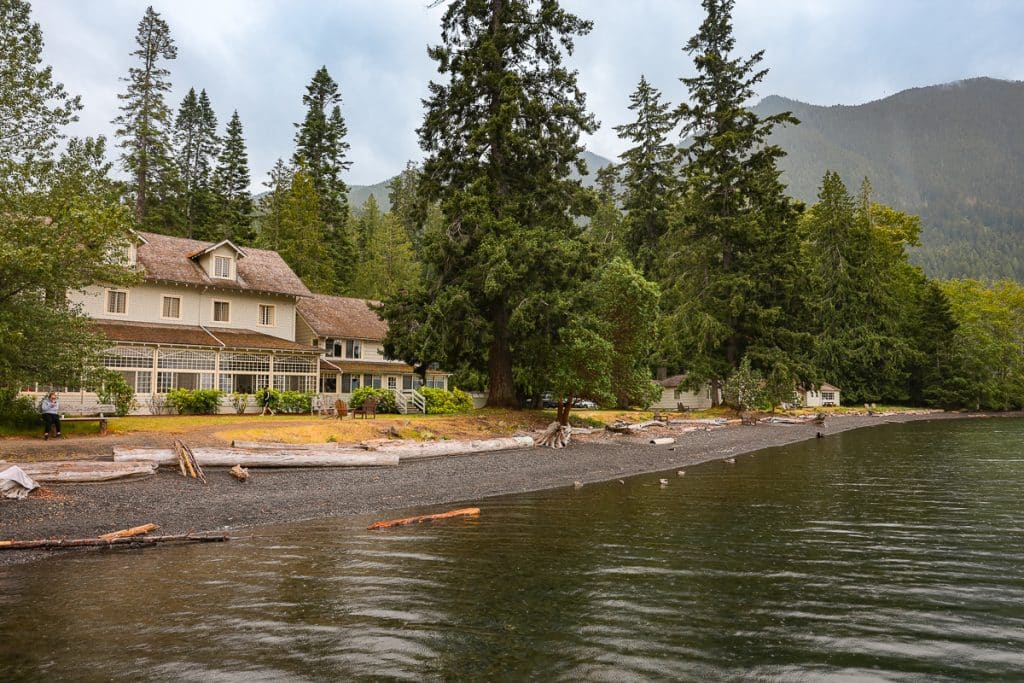
Where to Stay Near Mount Storm King
This interactive map can help you search all the available hotels and rental properties near Olympic National Park! Simply scroll and click the map below to see what is available!
Olympic National Park has several lodges and campgrounds. Of those, the options closest to Mount Storm King are:
- Lake Crescent Lodge (one minute drive or short walk to the trailhead)
- Log Cabin Resort & Campground (15-minute drive)
- Fairholme Campground (10-minute drive)
- Sol Duc Hot Springs Resort (35-minute drive)
- Sol Duc Hot Springs Campground (40-minute drive)
Read More: 15 Best Campgrounds in Olympic National Park
If you’re looking to stay outside the park, Port Angeles offers several hotels and is only a 30-minute drive to the trailhead. I recommend booking a room at one of these hotels:
- Sea Cliff Gardens Bed & Breakfast is a quaint bed and breakfast offering exceptional breakfast and spa-style suites.
- Olympic Lodge is a beautiful cozy lodge including an outdoor pool and fitness center.
Read More: Best Places to Stay Near Olympic National Park
Frequently Asked Questions About Hiking Mt. Storm King
Is Mount Storm King safe?
While some sections of the Mount Storm King trail are unmaintained and have steep drop-offs, the hike is generally safe for experienced hikers. However, the ropes section can be dangerous for unprepared people not wearing proper footwear like hiking boots. Only attempt the ropes section of the hike if you feel confident in your footing and ability.
Is Mount Storm King worth it?
Mount Storm King is only 4 miles but is a strenuous and tough hike. Nevertheless, the hike is worth it on a clear day as the views of the mountains and Lake Crescent are unparalleled. However, if you are uncomfortable with the final unmaintained stretch of the trail, the hike is not worth it as you only get unobstructed views from the summit.
How difficult is Mount Storm King?
Mount Storm King is rated as strenuous. The hike is around 4 miles round trip with over 2,000 feet of elevation gain. The elevation amounts to an average grade of 20%. The final stretch of the trail is increasingly difficult as it is unmaintained and requires the use of ropes to scramble to the narrow summit.
Do you need a pass for Mount Storm King?
You do not need a special permit to hike Mount Storm King. However, you will need to pay for entry to Olympic National Park. You can either pay your entry fee online or purchase a national park pass in advance. The park pass is valid for 12 months and gets you into all 400+ national park sites.
Final Thoughts on Mount Storm King in Olympic National Park
Mount Storm King is one of the most epic hikes in Olympic National Park, but it is also incredibly challenging. If you’re up for the strenuous 4-mile hike, it is truly a bucket list adventure and provides better views of Lake Crescent and the surrounding mountain range!
Don’t miss these posts if you’re looking for more Olympic National Park inspiration!
- Hiking: 21 Best Hikes in Olympic National Park
- Top Rated: 27 Best Things to Do in Olympic
- Where to Stay: 55 Best Places to Stay Near Olympic
- Camping: 15 Best Campgrounds in Olympic
- Washington: 3 Best National Parks in Washington
Are you planning a national park trip but don’t know where to start? Get my free 28-page national park ebook where I break down everything you need to know to visit all 63 USA national parks.
Download your free ebook here.
Don’t Forget to Save This Post on Pinterest
